We believe in the inherent opportunity every company has in entering the digital domain. Following is a sample Digital Opportunity Survey report. Take yours and get customized results.
There are 5 Key Areas that we consider in assessing your Digital Opportunity:
-
Strategy
-
Customers
-
Products
-
Analytics
-
The Market
You've just answered very specific and targeted questions in each of these categories in order to identify the opportunities that can be exploited and the gaps that need to be addressed.
The following report is based on your answers and is presented in three sections:

Where You’re At
Is Your Organization Ready for these Digital Opportunities?
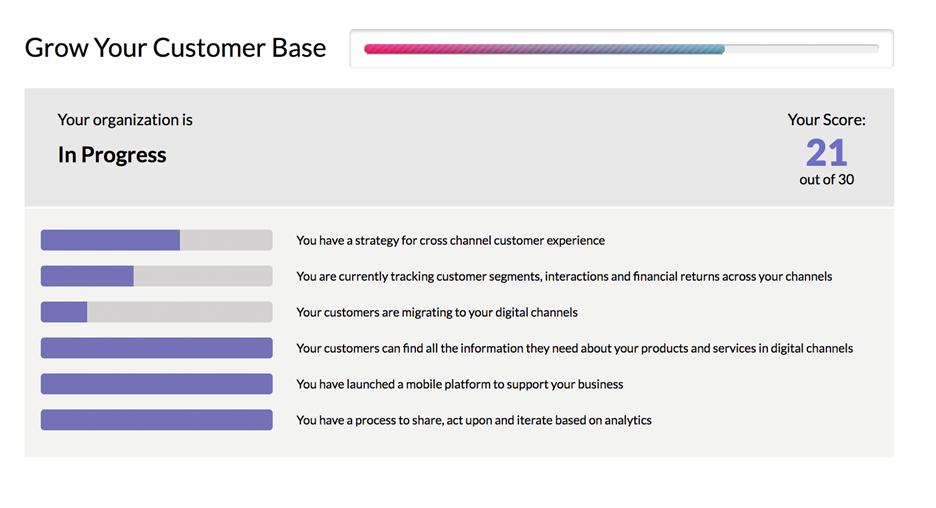
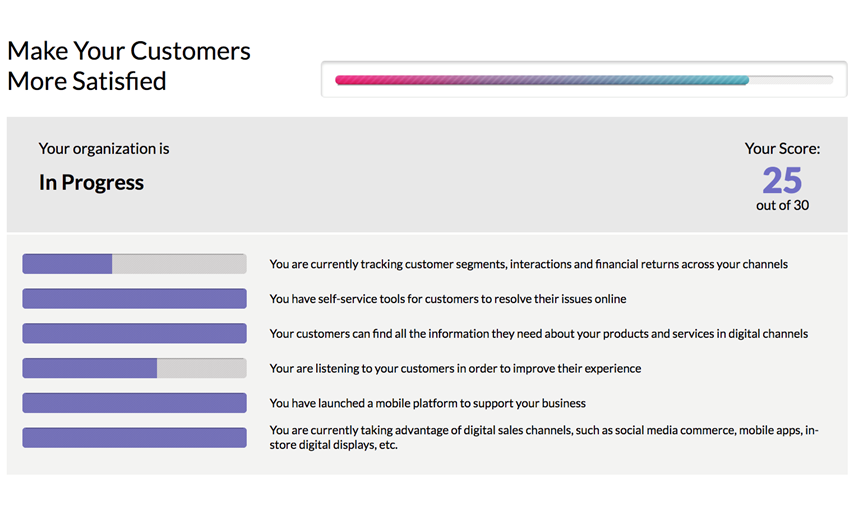
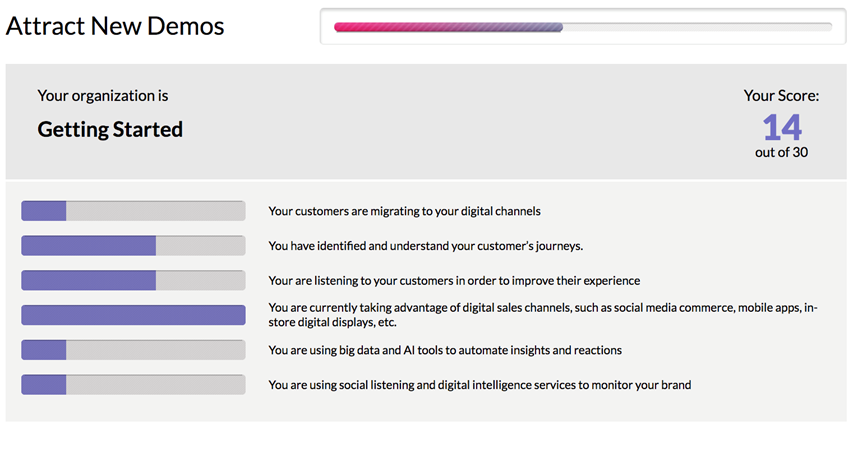
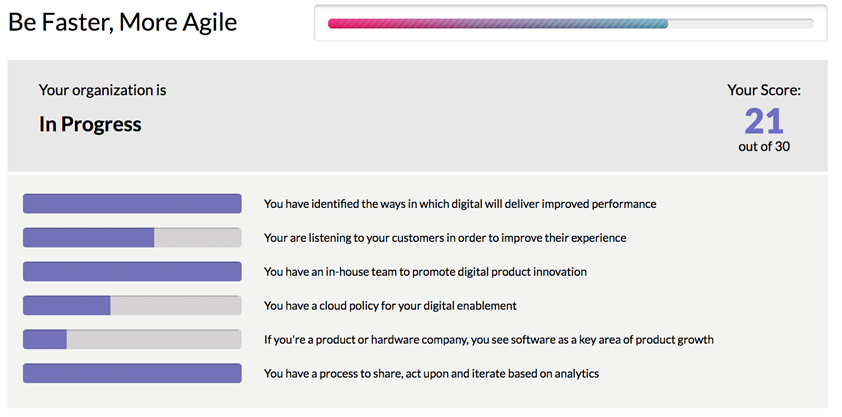
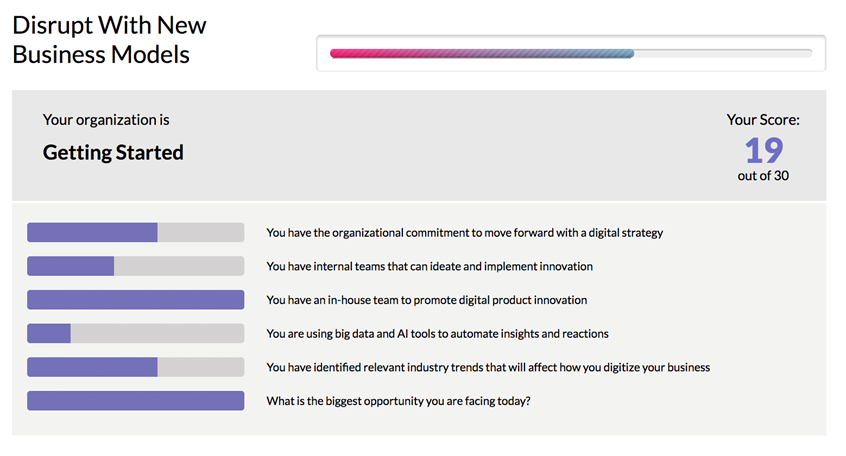
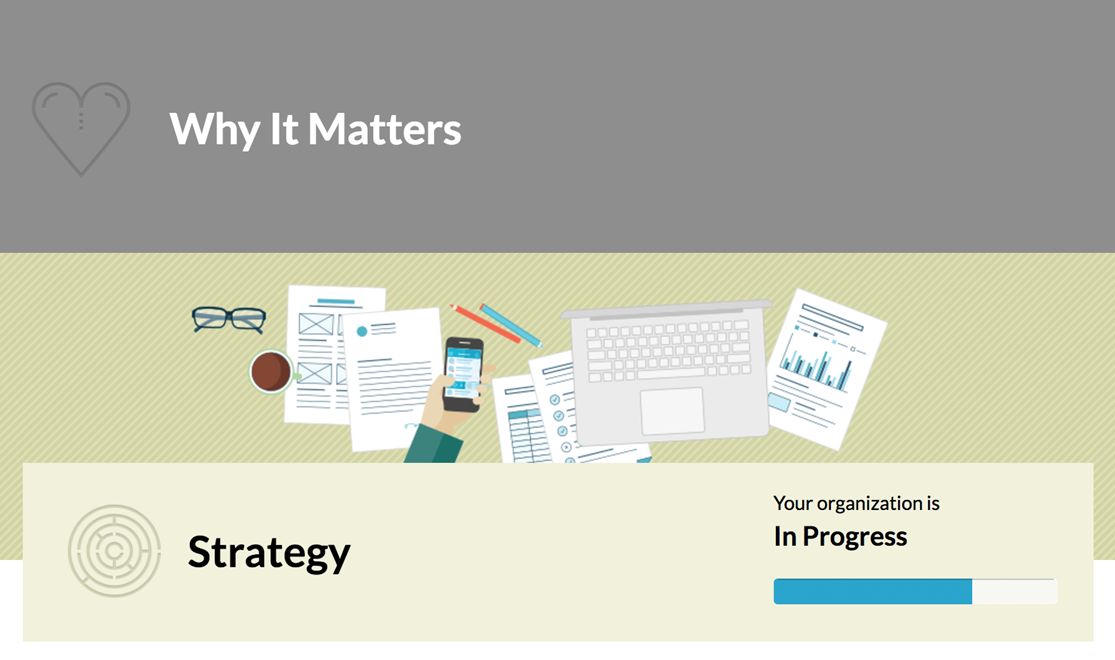
Digital Transformation Is About Strategy, Not Technology
Without a well thought out and articulated strategy, digital transformation will be about implementing technology or creating an app and not about the customer, the opportunity, the need or the business model.
The Five Phases of Digital Strategy:
- The Vision. We all need a vision. Before you can accomplish it, you need to envision it.
- Thinking it Through. Look inside to see your organization’s existing processes and ability to innovate. Look outside at the needs and desires of your customers and business partners, as well as understanding industry trends and competition.
- The Business Case. Digital will be able to optimize revenues and improve profitability at a specific point in time. Define the correlation between your digital initiative, its potential value to the company and what it will cost to get there.
- Prioritizing for Opportunities. Determine your organization’s digital strengths and weaknesses and prioritize to your quickest wins and nearest opportunities.
- Iteration and Innovation. The surest path to true innovation is iteration. Decide on a strategy, execute it, collect data and iterate. Once you have enough data and experience, you will have the capacity to create innovative, new business models and customer experiences.
You have a digital strategy and have considered many of the key elements that go into creating a customer-centric digital operation that can innovate and iterate based on customer feedback. You know how digital may be able to improve business performance and have considered the KPIs and metrics that will allow you to continue iterating and listening to your customers.
It is important to understand that strategy is also an iterative process. What works today may quickly require a pivot, or as you see your strategy unfold, you will find areas for improvement. Each phase of implementing your digital strategy requires a feedback loop, just like the digital applications themselves.
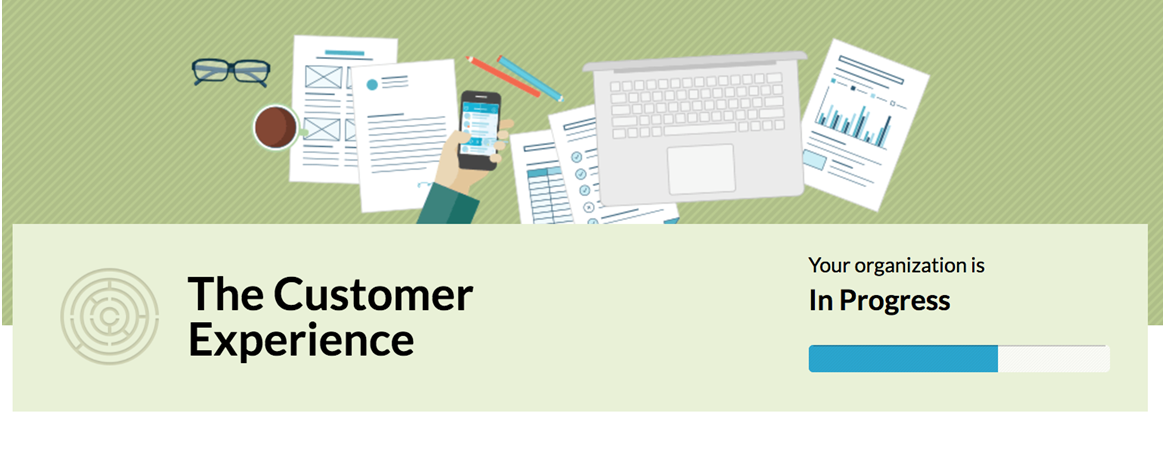
The Value of a Great Customer Experience
There is no doubt that customer experience (CX) is one of the major differentiators for successful companies today. CEOs are ranking CX as one of their top priorities. Hitting the CX challenge head on not only keeps competitors at bay, it also creates significant value. Each percentage point uptick in customer satisfaction can increase revenues.
Identifying and understanding the customer journey is about the complete, end-to-end experience customers have with a company. Not the one you want them to have, but the one they are actually having.
The truth is, no matter what we think we’re doing or making, we are all in the customer-experience business. The more committed we are to this principle, the more loved our brands are and the more successful we become. Is there anything more important than gaining greater satisfaction from your customers?
You have mapped out your customer experience strategy and are listening to your customers with the intention of continually improving customer satisfaction. It is worth noting that digital-first customer journeys rank much higher in customer satisfaction surveys than traditional ones. Even if the customer journey ends in a branch, beginning online increases the amount and degree of satisfaction.
Part of attracting customers online in the first place is a content strategy that increases your visibility and chance of discovery with useful information. You will also need to deploy advanced analytics in order to gain the insights required to increase customer loyalty, improve performance per segment and channel and even boost your own employee performance.
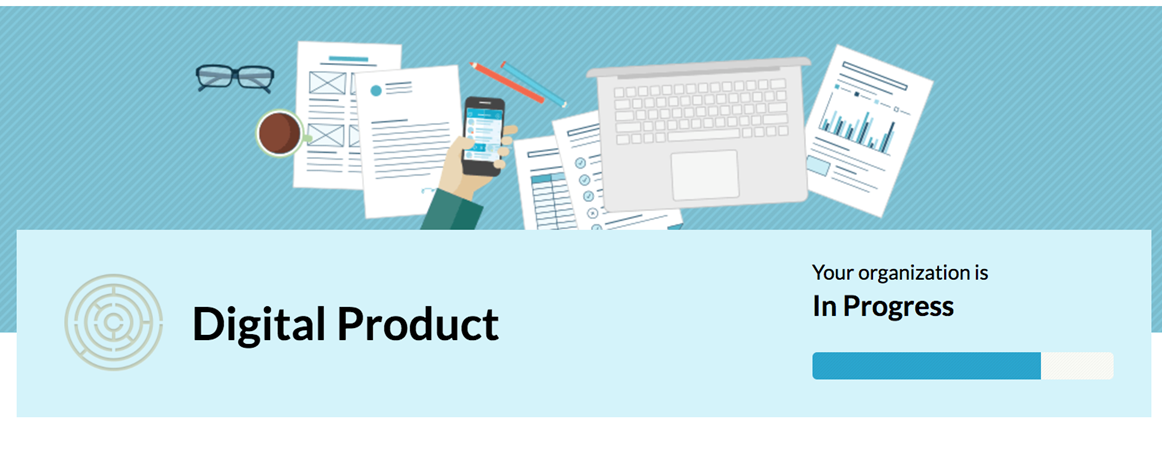
The Importance of Digital Influence
The main thesis that stands behind our Digital Me methodology is that digital and physical are no longer separated. They have seamlessly merged into a single journey. Our days are made up of countless moments and touch points where digital either intrudes, helps or provides clarification. Nowhere is this more evident than in commerce, where digital influences more than 50 cents of every dollar spent in retail stores.
Think about it, a customer who has had meaningful interaction with your brand or products prior to entering a store converts at a much higher rate, since the digital experience is part of the complete customer journey that ends with an in-store purchase. Most shoppers today have “checked you out” online before making a purchasing decision, making them more likely to make a purchase. The more commoditized the product, the higher the digital influence is.
In the early phases of digital adoption, an organization simply needs to build, react, iterate and learn. The next phase is to innovate with the insights you’ve gained and organizational strength you’ve built over time. The influence of a well-executed digital customer journey is felt in every industry today.
It’s great to see that your organization is making progress on bringing digital applications to the market. Creating innovative lines of business and applications is both a priority and serious frustration for corporate leaders. Surveys have shown the majority of global executives find innovation to be extremely important for growth, but most are unhappy with the innovation performance of their company. Innovation is very hard, requires a great deal of patience, investment and practice.
The primary issue in building a digital application is identifying exactly what progress the customer is trying to make at any given time. What does the customer need to accomplish? This is also known as the “job to be done” theory, which extends into any product category.
The driver behind innovation starts with solving that process or pain point for the customer. The Amazon Dash buttons are a great solution for making sure a customer never runs out of a frequently used product and cycles that purchase back to Amazon in the most efficient possible way.
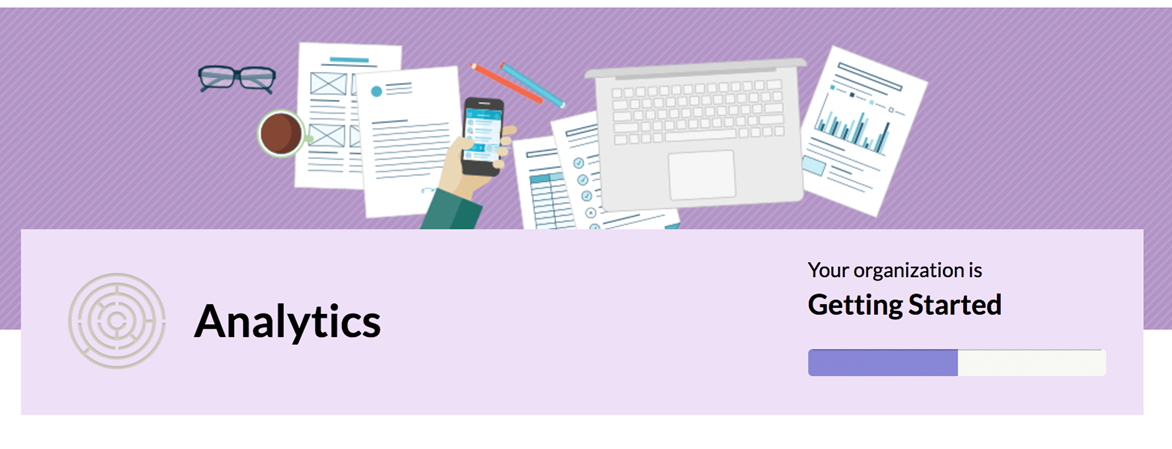
Separate the Hype from the Reality of Analytics
Big Data. AI. Machine Learning. IoT. Chat Bots. There is a huge amount of hype built around the value and importance of advanced analytics, but most industries are not even close to achieving the full potential of its use. A recent McKinsey Global Institute survey that measures the state of big data showed most industries capturing between 10-40% of the business performance improvements they expected from big data.
One of the main problems is embedding analytic insights into the organization. It’s much easier to pull off some experiments than it is to institutionalize the findings on a daily basis across departmental silos. Organizations not only need to know which data to collect and how to create value from it, they need the right capabilities to translate between the business functions and the data scientists.
As you are embarking on your journey into big data and analytics, less is more at first. Determine the most important pieces of information you need and hit a homerun with that. From there you can build out your data collection and analytics capabilities.
The ability for big data to enable and empower business is improving daily. Although data and analytics has been around quite a while, data science is a much more recent development. Even working in a newly data-driven environment can be difficult for people not used to it.
One of the basic challenges is knowing what to ask of the data scientists or systems you are using. As you begin working with your analysts, be clear about what you need to achieve. What business impact do you want the data to have? How will the company be able to act on these insights. Once the analysts know what you need and why, they will collaborate with you to generate the right questions and provide you the architecture and information you need, provided there is access to the required data.

Digital Transformation is all about seizing opportunity and keeping up with a changing market
Imagine you’re the CEO of Kodak and someone in the marketing department tells you about this digital photography thing. You look into it and think, oh cool, that could be a great line of business for us. Let’s get on it and figure it out. Or you say, digital is not our business model, we sell film. Do we even remember the name of that CEO? But we know what happened to one of the most storied companies of it’s time. It tanked. In 1997 they had a $30B market cap and today, after something of a revival in fortunes, sits at around $650M. This is the bloody side of disruption.
Understanding the trends and impact digitization has on your line of business is critical to the survival of your company. We look at the vast opportunities available in opening up digital channels, because in this world, we are all equal. Any incumbent can be pulled down a notch or more by a newcomer and any company with the heart, guts, soul and strategy - can leapfrog more digitally advanced competitors.
When it comes to the market, we prefer to go out swinging and improve with time. If Kodak had even taken some small steps in the early disruption of film, they could have been unbeatable.
In the digital world, a strong brand is more than just an image, it is the combined sense of a delightful customer experience, high functioning processes and operations and compelling business models.
The digitally empowered consumer has redefined marketing more than any other function with increasingly higher expectations of convenience, efficiency, and rewarding experiences. If a brand experience is disappointing, finding better options is a tap away, bringing new meaning to the phrase “love-it-or-leave-it”.
When acting upon the opportunities digital presents, the marketing function takes a lead role in defining the entire customer journey, not just demand generation. Every touchpoint in the customer experience with your brand needs to guide the relationship.
Maintaining clear brand positioning across every touchpoint will make you stand out and will provide customers with a more rewarding and consistent user experience. It was always true, but with the ease of access in digital, your brand is deeply rooted in every aspect of the business, none more so than the added convenience of properly exploiting digital channels.



